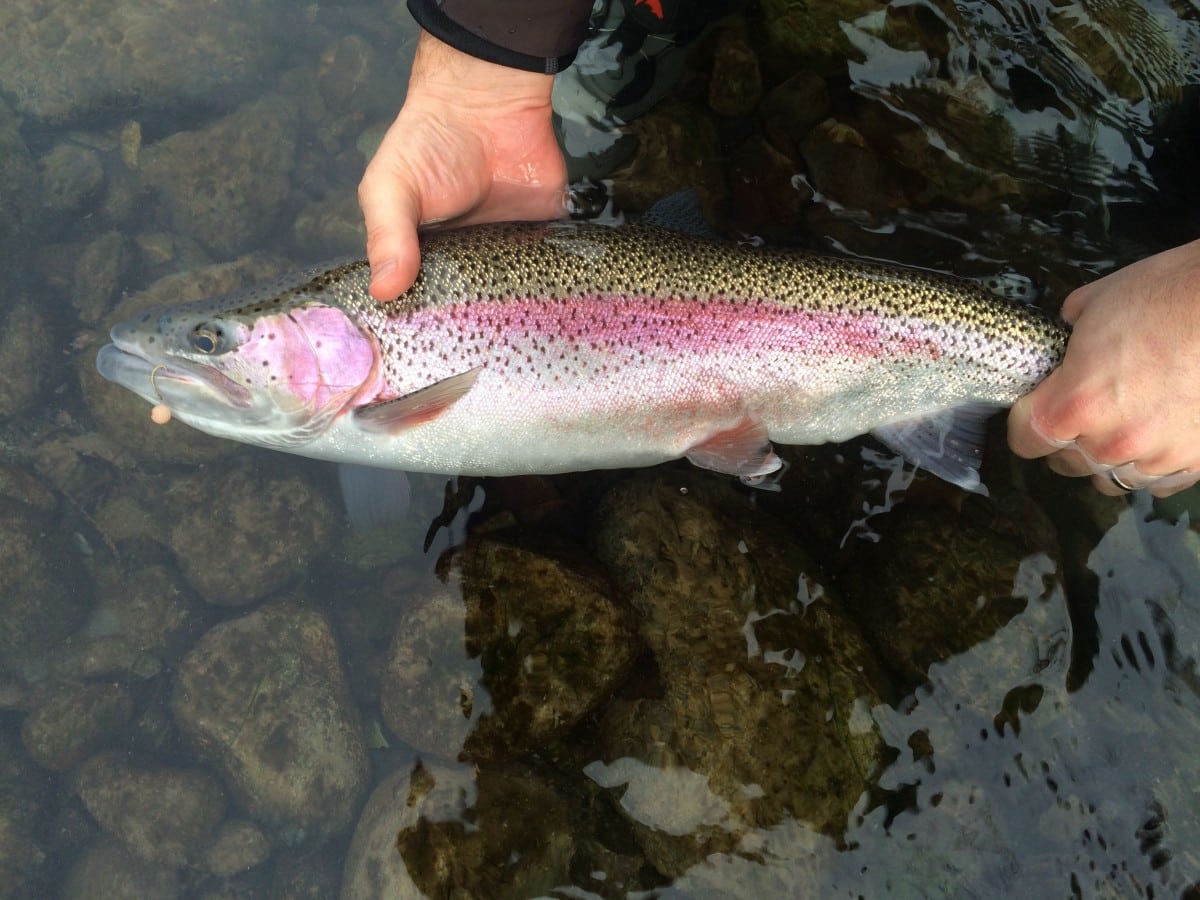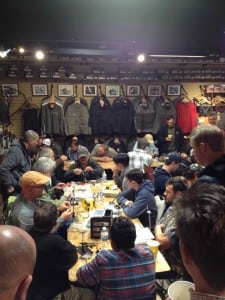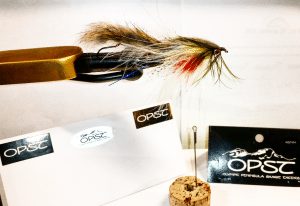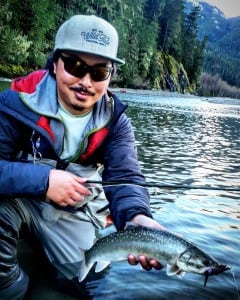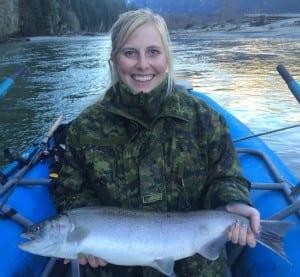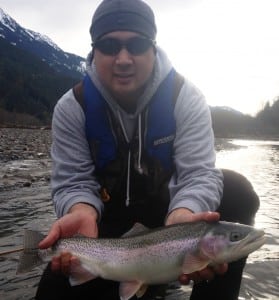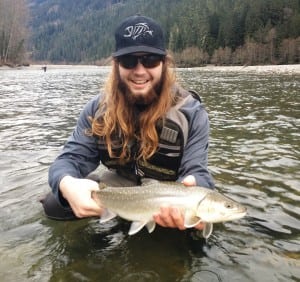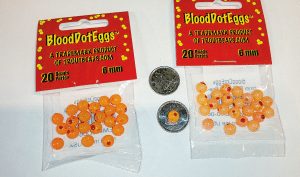OUTLOOK
Well it has been a busy week here in the shop and out on the water. This week was full of great industry events, ranging from our Pacific Angler Steelhead Fly Tying Jam Session, the Steelhead Society of BC’s annual pub night, and tonight’s Sport Fishing Institute of BC’s Big Splash Gala. What a great week to connect with friends and fellow anglers and support some awesome causes in our industry!
Out on the water we have been enjoying the cool, dry weather and have made up for lost time earlier in the season. While salmon season is wrapping up we have landed a few nice coho throughout the week on the Squamish and bull and rainbow trout fishing has been productive on both the Squamish and the Stave. If you’re looking to get out to do some trout fishing, be sure to read Matt’s Squamish report below for a detailed overview on one of his favourite techniques, egg fishing.
For those who are dreaming about getting back on the salt chuck, we haven’t had too many reports from those who have braved the cold to chase some winter chinook but that should change soon as we are almost into December.
COURSES
While our courses have wrapped up for 2015 the full 2016 lineup will is nearly ready to be announced here! As a newsletter subscriber you will be the first to know!
EVENTS + INDUSTRY UPDATES
Steelhead Fly Tying Jam Night – Thanks for an Awesome Evening!
This week’s Steelhead Fly Tying Jam Session was a huge success! A big thank you to all of our expert tiers who joined us for the evening to share their tips and tricks for their favourite steelhead patterns. Also, thanks to all who came out to enjoy the evening and socialize with your fellow tiers and anglers.
Finally, thanks to our friends at R & B Brewing for providing us with tasty beverages for the evening. We can’t wait for their Tap Room to open up mid January, as we’re sure it will be a staff favourite for post work dinner and drinks in the neighbourhood. If you can’t wait until January to get your R & B fix, head on down to the Growler Station to fill up your growler; open Thursday – Sunday and pick up some great beer!
Shop the Neighbourhood
November 28 marks the second annual Yellow Pages Shop the Neighbourhood. Join us in celebrating small businesses in neighbourhoods across Canada!
All in stock fly tying materials and tools will be 10% off!
Celebrate Pacific Angler and small businesses in our neighbourhood (our yours). Check out the YP Shopwise app for all the local participating businesses and deals!
PRODUCT FEATURE – OPST Dumbell Eye Shanks
New in the shop for this upcoming steelhead season are the OPST Dumbell Eye shanks. The folks over at Olympic Peninsula Skagit Tactics have designed this shank with the wire that forms the eye of the hook doubling back part way. This unique feature aids in keeping dumbell eyes from spinning around the shank when tying them in, also helping to save thread.
These shanks are great for not only tying intruder-style flies, but are also great for tying streamers such as sculpins. The over-all physical weight of these shanks is also a little heavier than standard light-wire shanks so if wanted, smaller dumbell eyes can also be used.
FRESHWATER REPORTS
Chilliwack
With only a few more days left in November and in our fall salmon fishery you can expect the fishing to be slowing down. If you decide to head out this weekend you may encounter the odd late running chum or coho salmon. Fish lower down in the river to increase your odds of finding fresh fish. Float fishing jigs and roe for the conventional angler. Swinging popsicle patterns as well as flash flies for the fly angler. Hopefully everyone had a chance to get out and enjoy the fall salmon fishing this year good luck to those of you who will be heading out this weekend for one last hurrah.
Capilano
The salmon season has come to a close on the Capilano. The fish that are still swimming are dark and ready to spawn. Although the salmon fishing is over, this is a beautiful time of year to walk around the canyon and check out the fish in the hatchery!
Squamish
The river was in good shape all week minus the cold weather. We saw salmon fishing slow, but we had good bull trout and rainbow fishing and even landed a few late season coho on our trips. We were also out on the water for the first installment of our famous egg fishing course and though we had to work for fish at times, we hooked a good number over the two days and everyone learned a lot.
This week on the Squamish we expect the river to be clear with the cold weather. This means fishing pale colored eggs and lighter fluorocarbon leaders. If you still want to target coho there should be a few around so bring small olive and chartreuse patterns but be gentle with the fish. If they are older red fish they are almost into the spawn and should be released quickly. If in doubt we suggest sticking with bull trout/rainbow fishing.
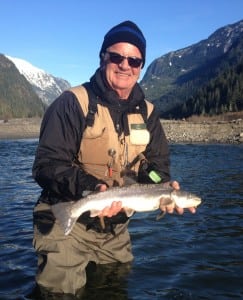
Garth with a Squamish bull trout landed during his on the water day for the Fly Fishing Egg Patterns course.
If you like to gear fish, spinners and spoons are always effective for both salmon and bull trout but if you want to target trout without using a fly rod, a light centerpin rod or float rod is a great way to present the same bead eggs we will talk about in the fly fishing egg set up below.
Egg Fishing 101
Given where we are at in the season I thought it would be a great idea to take a hard look at the egg fishing technique and setup in this week’s report. The Squamish egg fishery will fish well for the next two months but there are also a number of other systems where you can put the technique into practice.
First off what is egg fishing? For the most part all systems that have a salmon run will have sea run and resident fish (bull trout, cutthroat, rainbows and whitefish) that rely heavily on the salmon eggs as a food source during the salmon run and then for the 2-4 months the salmon eggs are hidden under the gravel in the river.
The key to the technique is twofold; first how we imitate these eggs with flies, beads or float fishing artificial rubber eggs and second how we present the imitations.
The set up for the fly fisherman can be simple or quite complicated. We recommend wool egg imitation, hot glue imitation and one of the most popular methods is to use beads colored like salmon eggs. All three of these imitations have merit and having a couple options in your arsenal is not a bad idea.
The classic wool tied eggs are very easy to use and can be a godsend when hands are cold. They are easy to tie on and if you are a fly tier they are easy to make. I always recommend every angler have a couple in their box, be it for a fast fly change or in situations like on the Stave River where there is a sizable population of whitefish that have very small mouths and they have a hard time getting larger egg presentation in their mouths.
With these exceptions the bead presentation has become our go to method for the Squamish with a number of benefits over more traditional wool egg flies. First off, beads have buoyancy that is very similar to a real salmon egg. This allows them to drift and tumble over rocks in a much more realistic fashion. The second benefit is we can fish them, pegged 2-4inches above a very small hook. This pegging allows the fish to swallow the bead but not swallow the hook. You will get better hookups in the outside of the fishes mouth and lower your chances to pipe hook fish (deep hook) and damage them. You will also find that the pegged bead can sometime buy the angler a slightly longer reaction time when setting the hook. Finally, the beads are cheap and come in a myriad of colors.
At Pacific Angler we suggest two ways to set up this bead rig. This week I am going to lay out the “Simple Rig”. As the name suggests it is simple and easy to use. Next week I will be looking at our advanced rig that we have developed over the last five years specifically for the conditions we face on the Squamish. That said the simple rig is the way to go if you are new to this style of fishing.
Pacific Angler’s “Simple” Egg Nymphing Rig
We use a standard 9ft tapered leader usually in the 6-7lb range. Rio Power Flex Trout leaders are our favorite, though if you can spend the money for a full fluorocarbon tapered leader it is well worth it. They sink better and are clearer. We tie a swivel to the end of the leader. From the small swivel we tie 18 inches of 5-7lb fluorocarbon. Rio Fluor plus, grand Max and Airflow sight free fluorocarbons are awesome. At this point you slip on the bead and use a trout peg or toothpick to peg the bead 2-4 inches above a #8 black Gamakatsu or Tiemco 2499SP-BL. Just above the swivel we anchor a #1, AB or BB size wingless split shot. Wingless is the key here because winged split shot tangle very easily.
Once this is finished all that is left to do is to put on the strike indicator. You can do this technique without a strike indicator, but without it you will not get as drag free a drift and will not catch as many fish. The indicator should go on the line 1-3ft into the heavy top section of the tapered leader. We like to focus on water that is 3-6ft deep for this technique and there is a rule that we need to fish a leader that is 1/ 3rd longer than the depth. So if you have 6-7ft from your indicator to you split shot you are fishing 4-5ft of water effectively. Adjust appropriately with this equation for your spot.
Technique
The technique of nymphing is almost more important than the set up. The concept of a drag free drift is essential. This means that there is no drag on the line so the egg pattern floats naturally down stream. You accomplish this with constant mending to correct for current drag. When the fish bites you will not feel the bite, but you will see it on the indicator and you will need to set the hook as fast as possible.
Don’t hesitate to drop by the shop if you have any questions on egging! Good luck out on the water and remember that the entire system is a single barbless, catch and release fishery with the exception being hatchery coho but these fish are extremely rare.
Matt
Chehalis
The Chehalis is a great late season coho river and probably one of the last rivers to see fresh fish. We heard a few good reports from guys float fishing the river last week and it is not a bad time to get out and scout for the first winter run steelhead of the year. Historically steelhead do not show up in numbers until January but a few are caught in December every year and boot time now will pay off later.
Matt
Harrison
The levels are dropping but it is safe to say the salmon season has come to an end. I had some reports from customers who braved the cold and went fishing last week but couldn’t find any coho. I will start the reports on the Harrison in the spring of 2016 when the cutthroat season starts. Be sure to check out the dates for ” Fly fishing for sea-run cutthroat ” course, as that’s a great way to get started or brush up on this fishery.
Andre
Stave
Being connected to the Fraser, most of the coho and chum that were headed that way are already in the system. If a fresh group of fish is found, your best bet is to have a variety of lures and jigs as well as various sized and coloured flies. Don’t be surprised if a cutthroat trout hits your offering as these fish are also found throughout the system and can be targeted using similar tactics.
Being as far along as we are into the season, actively spawning or well-coloured fish should be left alone. If one is incidentally caught, please handle it the least amount as possible and release it with care.
Though salmon and trout are the fisheries focused on the most in the Stave, a fun way to change it up is to ‘egg’ for the abundant whitefish that can be found throughout the system. Your standard trout sized fly rod will work great, but to really appreciate their feisty nature and attitude, 3 and 4wt rods are ideal. If you’re at all familiar with indicator or high-stick nymphing/beading, then you’ll do just fine. If you’re not, come on into the shop and we’ll be more than happy to help get you sorted out.
One thing to remember is that these fish have fairly small mouths, and your offering should match. Glo-bugs and other yarn based egg patterns, including crafting fuzz balls, should be small to tiny. If using beads, you’ll want to go down to 6mm as opposed to the more standard 8mm that we often use for bull trout and rainbows.
Another thing to remember when scaling down your offering is to scale down your tippet. Instead of the usual 6 to 8lb fluorocarbon, you’ll want to go down to 3 or 4lb tippet, and of course, hooks to match!
Jordan
Fraser (tidal/non-tidal)
With most of the salmon season having passed, anglers fishing the Fraser will be focusing on coarse fish with ultra-light tackle or targeting char and cutthroat in the various backwaters and sloughs. Small spinners, spoons, and various flies are all great choices. Gear doesn’t need to be heavy with most trout-sized gear being a great choice, including fly rods in the 5-6wt range. Floating lines with Versi/Poly leaders in various sink rates are all that’s needed.
Jordan


